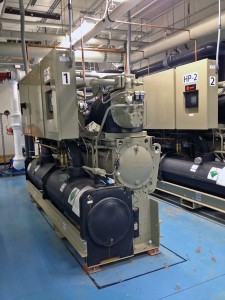As energy bills are rising for most people across the state, the Alaska SeaLife Center’s are actually dropping. That’s because they’re using the cold waters of Resurrection Bay to heat their building.
Agnes is a seven-month-old sea otter pup who was rescued and sent to the Alaska SeaLife Center in Seward. She’s swimming around a pool with another orphaned otter.

The center’s marine mammal curator Derek Woodie says the otters don’t have any blubber, they rely on their thick coats of hair to stay warm.
“What they do is groom themselves and they’ll blow air into that fur and they create like a little bubble of air, almost like a wet suit, and it keeps them warm in that 40 degree water,” Woodie said.
That same chilly water rushing into Agnes’ pool is also being used to heat most of the building.
“It’s hard to explain, it doesn’t actually seem logical,” Tara Reimer Jones, president of the SeaLife Center, said. “I’m actually trained as an engineer and it still doesn’t quite make sense to me, but essentially we’re running reverse refrigerators.”
The SeaLife Center converted to the seawater-heat pump system to save money – tons of money.
In 2008, the center heated with oil and their energy bill was $1.2 million. Last year they spent less than half that amount. With savings like that, the entire system will be paid off in eight and a half years.
“Being able to reduce our energy costs as much as we have has enabled us to stay successful and be open to the public and keep our costs under control,” she said.
So how does it work? Facilities Director Darryl Schaefermeyer takes me to see the system.
First, they pump seawater into the building. They already do this to fill tanks and pools for the animals.
“Right now we’re probably pumping about 3,000 gallons per minute of sea water constantly through the building,” Schaefermeyer said.
Some of that seawater goes into a tall, thin metal box called a heat exchanger. You know when you open your window in winter and all of your heat rushes outside? It’s trying to warm up the cold air. The same thing happens inside of the heat exchanger. The seawater runs on one side of a titanium plate. On the other side is basically water and antifreeze. The heat from the seawater rushes into the antifreeze mix, warming it up to the same temperature. Schaefermeyer says it then goes to the heat pump, which is run by electricity.
“The refrigerant comes into contact with that 47 degree water temperature, causes it to boil, turns it into a vapor,” Schaefermeyer said. “Then there’s compressors in the heat pump that compress that vapor and it gets very hot.”
That compressed vapor produces the 120-degree water that heats the building and the pavement. Then the antifreeze loops back to the seawater to start the process all over again. Schaefermeyer says for every unit of energy added to the system, you get out three units of heat. And it’s more efficient with higher loads. He hopes the technology will be used beyond the SeaLife Center.
“We want to be able to ultimately see this technology exported into areas where we can heat downtown business districts, communities, literally with this heat,” he said.
And it is possible. Andy Baker, the consultant who helped design the Center’s system, says ocean heat pump technology is already widely used in Norway and Sweden. You just need community buy-in – and cheap electricity.
“If you’ve got low cost hydropower and expensive heating oil or propane, that’s where you’re going to see the heating pumps going in first,” Baker said.
Baker says people are even starting to install small-scale projects that work on the same concept but draw heat from the ground or lakes instead. But the technology isn’t useful in some of the communities that need it most.
“Its tougher because the cost of power is usually a lot higher. The cost of power, for example in Dutch Harbor, is about 42 cents per kilowatt hour,” Baker said. “That’s more than twice what it is in Seward, so the economics aren’t nearly as favorable there because of the high cost of power because it’s made from diesel fuel.”
But in Seward, where electricity is supplied by Chugach in Anchorage and runs about 12 cents per kilowatt hour, the innovation helps keep Agnes the otter happily swimming and squeaking.
“Agnes is a very vocal animal. It just happens that way.”
Anne Hillman is the healthy communities editor at Alaska Public Media and a host of Hometown, Alaska. Reach her atahillman@alaskapublic.org. Read more about Annehere.





